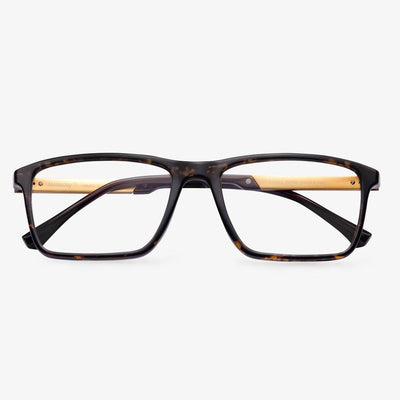Blue light blocking glasses lenses and common glasses lenses have different colors.
The real blue-light-blocking glasses should be yellow. Based on the primary principles of optics, the light reflected from the lens is the light that resists the same color as it. As the name indicates, blue light is to prevent the reflection of blue light. Remove blue light, and all the red, yellow, blue, and green in visible light is yellow.
The frames should be the right size.
When choosing glasses for kids, pay attention to the size of the frame. Be careful not to choose frames that are too big for your child, and avoid frames that will create shadows or blind corners.
What are keyhole glasses used for?
The keyhole distributes the weight of the glasses to one side of the nose rather than the top. It's a good choice for those with broad noses. Due to the lack of support at the top, the keyhole design will result in the frame being positioned lower than the saddle bridge frame. If you find that your saddle frame causes your eyes to be located just below the center of the lens area, you may try a wider frame or opt for a keyhole design.
What Do Progressive Glasses Mean?
Progressive lenses, also called PALs, are the most popular multifocal lenses today. They offer an effective and great-looking vision solution for individuals with presbyopia. The main benefit of progressive lenses is that they do not have a visible line bisecting the lens, but rather a seamless and gradual change in power as you move down the lens.
Rather than two or three distinct zones, progressive lenses offer a smooth transition of focal powers that covers the total range of clear vision from close to far and every point in between.
Glasses should not have serious color differences.
Children's eyes are not fully developed, and the eyeball is still growing slowly, at this time it is best not to wear such blue light glasses with the serious color difference. If you always see things with color differences, it will cause eye discomfort, resulting in increased myopia, but the opposite. The big color difference will cause low light transmittance, affecting child macula development. In the case of long-term distortion and discoloration, visual physiology and psychology will be affected.
Blue light glasses for children have special lenses that block some light waves, which may help protect children's growing eyes from digital eye strain. Blue light lenses sometimes have a slight yellow tint. You can buy prescription or non-prescription glasses with child-size frames and lenses that filter blue light. They don't filter out all the blue light, but they can reduce your child's exposure to blue-violet light by 80 percent or more.
The function of eyeglasses cloth
Under a powerful microscope, the fibers of the cloth are more closely arranged than those of ordinary cloth, and the material itself is softer than ordinary cloth. That's because eyeglasses under the eye are almost always coated, with each standard lens having seven layers of different functions on the front and back surfaces, to extend lens life. It can thoroughly remove the stubborn stains left on the lens to make the picture clear. It can clean all kinds of glass, resin, and other materials of glasses, glass mirrors, and other mirror surfaces, remove stains, and grease absorption.
What Are Trifocal Glasses?
Trifocal glasses and no-line progressive lenses are multi-focal glasses, meaning that their lenses offer multiple correction fields. Whether you have been wearing multi-focal glasses for a while, or you have just begun to look at options for correcting vision after 40 years old, you may have heard the terms trifocal or progressive glasses.
Trifocal glasses have three different corrective lenses within one lens to offer you intermediate, distance, and near correction. Trifocal lenses look and perform similar to bifocal lenses, with an added viewing zone to help correct vision in the intermediate field, and two visible lines where the viewing zones change.


















































